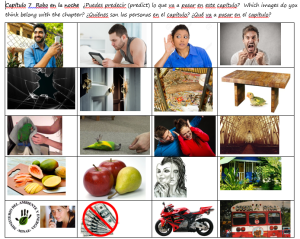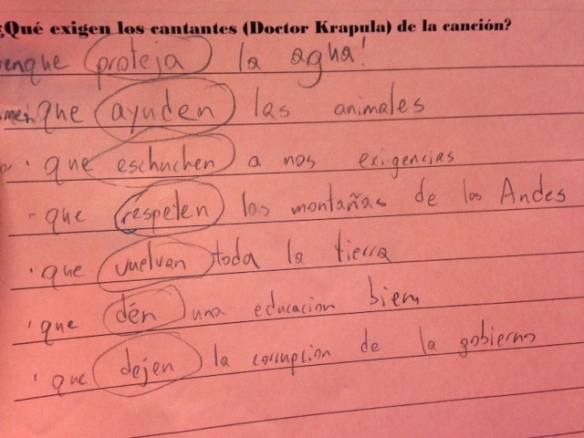This is the third time that my fabulous colleague, Megan Matthews, and I are teaching Robo en la noche by Kristy Placido. The first time was two years ago and we rushed through it in the final weeks of school, relying heavily on the terrific resources from Cynthia Hitz. The second time was last year and the rhythm of teaching was disrupted multiple times by many snow days and the intrusion of PARCC testing that disrupted our schedules for weeks. This year, the third time, we have only had two snow days, and the book is flowing very well. We have continued to add resources to the novel as we ourselves expand our knowledge of TPRS and CI techniques to complement some traditional methods. Previously, I have blogged twice about Robo, see here and here. Since it is a snowy President’s Day here in Maryland (and I should be grading papers!), I decided to post some of these new resources that might be of interest to others who are using Robo en la noche, also. We are going to be starting chapter 9 this week.
Chapter 2: Chap 2 picture sort and group presentation With this activity, I gave every student a laminated card (took the luxury of printing them in color!), and they had to decide how to group themselves. The tentative categories were Makenna, Margarita, Costa Rica, Cecilio, etc. My Spanish III classes have between 24 – 28 students, so I needed a lot of pictures! Once they decided their own groups, they worked together to create a presentation about their category. I gave them about 4 minutes, and they shared it with the class, using their pictures to illustrate what they were saying. I think that in the future I might follow that with having each group write an individual summary of their presentation. Note: Some of the pictures could fit into more than one category, it was up to the student to decide where to go. Prior to their group presentations, I had the class assess whether the pictures were in the correct grouping, and they were allowed to change, if necessary.
Chapter 3: This year Megan and I are really focusing on verbs and target structures. We spent a lot of time working on the various forms of casarse, embarazado, pensar, morir and sonreir. We had worked repeatedly with the various forms using a SMART presentation. Here are some samples from that: 


Our final repetition used this “Toca” board. ch 3 toca vocabulary  Working with a partner, students first identified the meaning of all of the structures. Then, each working with a different colored dry erase marker (the boards were laminated), I said one of the structures in English. The first to highlight the correct structure scored the point. We wiped the board clean and repeated this several times. By the time we actually read the chapter, all of these structures were easily understood by the students. There was absolutely no stumbling!
Working with a partner, students first identified the meaning of all of the structures. Then, each working with a different colored dry erase marker (the boards were laminated), I said one of the structures in English. The first to highlight the correct structure scored the point. We wiped the board clean and repeated this several times. By the time we actually read the chapter, all of these structures were easily understood by the students. There was absolutely no stumbling!
Chapter 5: Review bird with all characters  Working with a partner and different colored dry erase markers, students selected a character and said one sentence about that character, coloring through the character that they selected. Since the characters are within the bird multiple times, they were able to say many facts about each character without repeating. This activity lasted about 5 minutes; when they were done, they held up their birds (now colorfully illustrated), and, just for fun, we selected the “prettiest” bird.
Working with a partner and different colored dry erase markers, students selected a character and said one sentence about that character, coloring through the character that they selected. Since the characters are within the bird multiple times, they were able to say many facts about each character without repeating. This activity lasted about 5 minutes; when they were done, they held up their birds (now colorfully illustrated), and, just for fun, we selected the “prettiest” bird.
Chapters 5-6 Chapters 5 – 6 pictures for oral assessment smaller version I tried some variations with these picture cards (to be printed in color and laminated). The pictures can just be shown to the class, with the entire class adding descriptions to each picture. The pictures can be given one at a time to a group of 2 – 3 students, who describe the picture with as much detail as possible, and then pass the picture to another group. Or, using an idea from Carrie Toth, called the yellow brick road, I took the students into the hallway, made a “pathway (yellow brick road)” with the pictures and they worked (in partners) their way through each picture. I allowed about a minute with each picture before asking them to move one picture to their right/left. It was relatively easy for me to circulate and listen to their conversations to give them an informal speaking assessment.
Chapter 7 Capítulo 7 Robo en la noche predict the chapter  Prior to reading chapter 7 and working with a partner, students identified each picture and then selected which pictures they thought would represent what would happen in Chapter 7. They put an X on the pictures that they thought would not represent action in the chapter. After deciding, they turned the paper over and wrote 5 sentences about what they expected would happen in the chapter and then presented them to the class. Their ideas were certainly interesting!! After reading the chapter, we checked the papers/predictions again.
Prior to reading chapter 7 and working with a partner, students identified each picture and then selected which pictures they thought would represent what would happen in Chapter 7. They put an X on the pictures that they thought would not represent action in the chapter. After deciding, they turned the paper over and wrote 5 sentences about what they expected would happen in the chapter and then presented them to the class. Their ideas were certainly interesting!! After reading the chapter, we checked the papers/predictions again.
Chapters 7/8: Some game breaks
I hope that something in this post may be useful to someone else. If you are using this book, I would love to hear some of your ideas.







